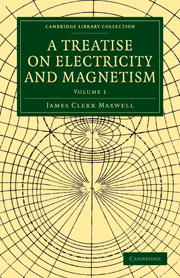Book contents
- Frontmatter
- PREFACE
- Contents
- ELECTRICITY AND MAGNETISM
- PRELIMINARY
- PART I ELECTROSTATICS
- CHAPTER I DESCRIPTION OF PHENOMENA
- CHAPTER II ELEMENTARY MATHEMATICAL THEORY OF ELECTRICITY
- CHAPTER III SYSTEMS OF CONDUCTORS
- CHAPTER IV GENERAL THEOREMS
- CHAPTER V MECHANICAL ACTION BETWEEN ELECTRIFIED BODIES
- CHAPTER VI POINTS AND LINES OF EQUILIBRIUM
- CHAPTER VII FORMS OF EQUIPOTENTIAL SURFACES AND LINES OF FLOW
- CHAPTER VIII SIMPLE CASES OF ELECTRIFICATION
- CHAPTER IX SPHERICAL HARMONICS
- CHAPTER X CONFOCAL SURFACES OF THE SECOND DEGREE
- CHAPTER XI THEORY OF ELECTRIC IMAGES
- CHAPTER XII CONJUGATE FUNCTIONS IN TWO DIMENSIONS
- CHAPTER XIII ELECTROSTATIC INSTRUMENTS
- PART II ELECTROKINEMATICS
- Plate section
CHAPTER XII - CONJUGATE FUNCTIONS IN TWO DIMENSIONS
Published online by Cambridge University Press: 05 July 2011
- Frontmatter
- PREFACE
- Contents
- ELECTRICITY AND MAGNETISM
- PRELIMINARY
- PART I ELECTROSTATICS
- CHAPTER I DESCRIPTION OF PHENOMENA
- CHAPTER II ELEMENTARY MATHEMATICAL THEORY OF ELECTRICITY
- CHAPTER III SYSTEMS OF CONDUCTORS
- CHAPTER IV GENERAL THEOREMS
- CHAPTER V MECHANICAL ACTION BETWEEN ELECTRIFIED BODIES
- CHAPTER VI POINTS AND LINES OF EQUILIBRIUM
- CHAPTER VII FORMS OF EQUIPOTENTIAL SURFACES AND LINES OF FLOW
- CHAPTER VIII SIMPLE CASES OF ELECTRIFICATION
- CHAPTER IX SPHERICAL HARMONICS
- CHAPTER X CONFOCAL SURFACES OF THE SECOND DEGREE
- CHAPTER XI THEORY OF ELECTRIC IMAGES
- CHAPTER XII CONJUGATE FUNCTIONS IN TWO DIMENSIONS
- CHAPTER XIII ELECTROSTATIC INSTRUMENTS
- PART II ELECTROKINEMATICS
- Plate section
Summary
182.] The number of independent cases in which the problem of electrical equilibrium has been solved is very small. The method of spherical harmonics has been employed for spherical conductors, and the methods of electrical images and of inversion are still more powerful in the cases to which they can be applied. The case of surfaces of the second degree is the only one, as far as I know, in which both the equipotential surfaces and the lines of force are known when the lines of force are not plane curves.
But there is an important class of problems in the theory of electrical equilibrium, and in that of the conduction of currents, in which we have to consider space of two dimensions only.
For instance, if throughout the part of the electric field under consideration, and for a considerable distance beyond it, the surfaces of all the conductors are generated by the motion of straight lines parallel to the axis of z, and if the part of the field where this ceases to be the case is so far from the part considered that the electrical action of the distant part on the field may be neglected, then the electricity will be uniformly distributed along each generating line, and if we consider a part of the field bounded by two planes perpendicular to the axis of z and at distance unity, the potential and the distribution of electricity will be functions of x and y only.
- Type
- Chapter
- Information
- A Treatise on Electricity and Magnetism , pp. 226 - 253Publisher: Cambridge University PressPrint publication year: 2010First published in: 1873



